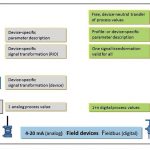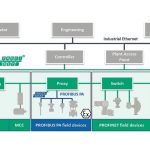Advancements in industrial communication technologies are having positive effects on field device handling in process automation systems. With the forthcoming introduction of Profinet, new properties demonstrate the innovative efforts of developers towards easy and reliable plant management.
Authors Karl Büttner (Endress+Hauser) Andreas Hennecke (Pepperl & Fuchs) Jens Scheib (Siemens) Members of the Process Automation Working Group, Profibus User Organisation e.V.
The familiar expression “the better replaces the good” is not absolute, as good and better are relative terms. A clear example of this can be found in the communication technology employed in industrial automation. In production automation, the well-proven and still viable digital fieldbus technology (Profibus DP) has for several years been gradually superseded by the Ethernet based Profinet, which is ranked higher by users. In this case, the aforementioned statement is true.
In process automation, on the other hand, there is still broad support even for the classic 4…20 mA technology, mostly in versions with additional Hart capability, though according to current surveys the latter is meanwhile utilised only to a very limited extent.
There are several reasons for this preference for pre-fieldbus technology: the fundamentally conservative and safety-oriented stance of this industry sector with its long plant lifetimes certainly plays a role. Another aspect is the nature and size of the plants, which owners believe will not derive sufficient benefit from switching to fieldbus. Finally, unfulfilled user expectations regarding field device handling in the beginning of the fieldbus era may be another reason. Whatever the explanation, it is users, and above all plant operators, who are responsible for choosing a particular communication technology. Developers and manufacturers of new technologies and devices (for example, PI and its member companies) can merely make innovative and advanced technologies available and provide information about the associated advantages.
Three technologies coexist
The rapid advancements in industrial communication technologies have resulted in the coexistence in the current of three technology generations in the conservatively minded process automation sector: 4…20 mA/Hart, fieldbus (Profibus PA) and Industrial Ethernet (Profinet). The latter is gradually making inroads into process automation and opening up new possibilities for plant operators. For infor-mation purposes and to aid decision-makers, these three technologies and the main options for handling field devices are outlined below.
Widespread and popular
In the case of 4…20 mA technology all installation and operating steps for the field devices, including cable routing for device infeed and signal transport, the dual signal transformation (analogue -> digital and back) and the device-specific parameter description in the controller, must be carried out individually for each device (Figure 1, left). For plants with hundreds or thousands of devices, this adds up to a tremendous effort which can hardly be justified economically. On top of this, the devices can only be configured in an installed condition, possibly at exposed locations in the plant, and the I/O cards must then be configured accordingly.
Owing to its age, 4…20 mA technology does not offer field device compatibility through a device profile, nor does it provide diagnostic capabilities beyond an error stream, making preventive maintenance and thus the targeted assurance of high plant availability impossible. Of course, users are attracted by the worldwide standard represented by the 4…20 mA interface, which however – as mentioned previously – comes at the cost of a considerable amount of work, a lack of information from the plant and no external access to the devices.
Powerful and very timely
The fieldbus solution corresponding to today’s technology generation – Profibus PA (or more precisely, Profibus DP with coupled Profibus PA) has been proven worldwide as a powerful so-lution that takes account of all process automation issues. Specifications and guidelines such as the PA 3.02 device profile provide the necessary standardisation, while the corresponding field devices from a wide range of manufacturers allow users a great deal of freedom when choosing instrumentation. In contrast to 4…20 mA technology, only a single (bus) cable is used. Likewise, there is no dual AD and DA conversion with corresponding accuracy loss and communication is bidirectional, enabling remote access to devices (Figure 1, right). Examples of the special support offered to plant operators include the ability to configure devices outside the plant, mechanisms for easy and reliable device replacement developed in close coordination with users, the implementation of Namur Recommendation NE 107 for classifying diagnostic information and last but not least the Fisco model, which sizes applications in hazardous locations without complex calculations. The common profile GSD for all profile devices forms a standardised interface, which is roughly comparable with the 4…20 mA standard of analogue technology (Figure 1).
Advances through Industrial Ethernet
As an Industrial Ethernet solution, Profinet is established in the production automation sector for communication in machines and plants, where it forms the technological basis for very high data consistency and plant availability. This same transition is now also starting to happen in process automation. The introduction of Profinet in process technology is taking place gradually on the basis of existing specifications, and additional specifications are in progress, with special attention being given to investment protection.
One proven, already implemented Profinet function which is important for handling field devices is network management with neighbourhood detection of devices. This function enables addresses to be assigned automatically when devices are replaced and displays the topology of a plant, for example to ensure that a replacement device is connected in the correct position. The replaced device is given the same name and parameters as the original.
Key specifications in place for process automation today include CiR (Configuration in Run) for making changes without disturbing ongoing plant operation, system redundancy for applications with very high plant availability requirements and Proxy for transparent integration of existing systems such as Profibus PA as well as other communication technologies in Profinet.
It is simply a matter here of implementation by the device manufacturers until the scenario shown in Figure 2 becomes a reality through a combination of Profinet and Profibus PA. PA Profile 3.02 is a proven device profile of special importance. It will be revised, expanded and qualified for use with both Profinet and Profibus.
Specifications and developments which are currently in progress or planned are aimed at a comprehensive Profinet solution, with PN devices for use in hazardous areas as well as two-wire technology for the power supply via the cable. This involves new technological territory, which is currently the object of intensive studies.
Outlook
Deliberately conservative and, for reasons of competitiveness, also explicitly focused on innovation – this is the impression created by today’s process automation environment. This situation will intensify further in the light of trends like Industry 4.0 and the Internet of Things. PI takes explicit account of these trends with the phased introduction of Profinet. This will provide the process industry with an extensible communication system that is fully compatible with Ethernet technologies, future-proof and supportive of plant operators.
Hall 11.0, Booth C43
cpp-net.com/0215435
Share:










